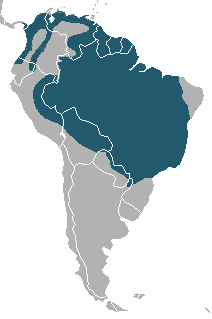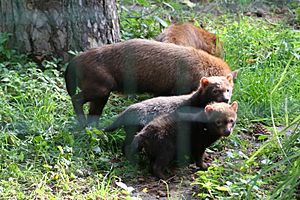Bush dog facts for kids
Quick facts for kids Bush dog |
|
|---|---|
 |
|
| Bush dog at Prague Zoo | |
| Conservation status | |
| Scientific classification | |
| Genus: |
Speothos
|
| Species: |
venaticus
|
| Subspecies | |
|
|
 |
|
| Bush dog range | |
The bush dog (Speothos venaticus) is a type of wild dog found in Central and South America. Even though it lives in many places, it is quite rare in most areas. You can find more of them in Suriname, Guyana, and Peru.
Scientists first learned about the bush dog from fossils found in caves in Brazil. At first, they thought it was extinct, but it wasn't! The bush dog is the only living species in its group, called Speothos. Its closest living relatives are the maned wolf from South America and the African wild dog. The bush dog is currently listed as "Near Threatened" by the IUCN, which means its numbers are getting low.
In Brazil, people call it cachorro-vinagre ("vinegar dog") or cachorro-do-mato ("bush dog"). In countries where Spanish is spoken, it has names like perro vinagre ("vinegar dog"), zorro vinagre ("vinegar fox"), perro de agua ("water dog"), or perro de monte ("mountain dog").
Contents
What Bush Dogs Look Like
Adult bush dogs have soft, long fur that is brownish-tan. Their head, neck, and back might have a reddish color. Their belly is dark, and sometimes they have a lighter patch on their throat. Young bush dogs, however, are completely black.
Adults are usually about 57 to 75 centimeters (22 to 30 inches) long from head to body. Their tail is shorter, about 12.5 to 15 centimeters (5 to 6 inches) long. They stand about 20 to 30 centimeters (8 to 12 inches) tall at the shoulder and weigh 5 to 8 kilograms (11 to 18 pounds). They have short legs, a short snout, and small ears.
Their teeth are perfect for eating meat. Unlike most American wild dogs, bush dogs have special teeth that are very sharp for cutting. They also have partially webbed toes, which help them swim really well!
Bush Dog Genes
Bush dogs have a special number of chromosomes (74). This means they cannot have babies with other types of wild dogs, so they only breed with other bush dogs.
Where Bush Dogs Live and Their Homes
Bush dogs live in Costa Rica in Central America and across much of South America, east of the Andes mountains. You can find them as far south as central Bolivia, Paraguay, and southern Brazil.
They mostly live in lowland forests, wet savannas, and other places near rivers. They can also be found in drier areas like the cerrado and open pastures. Bush dogs have even been seen in the Talamanca Mountains at high elevations.
There are three main types of bush dogs, called subspecies:
- The South American bush dog (Speothos venaticus venaticus) lives in southern Colombia and Venezuela, the Guyanas, most of Brazil, eastern Ecuador and Peru, Bolivia, and northern Paraguay.
- The Panamanian bush dog (Speothos venaticus panamensis) lives in Panama, northern Colombia and Venezuela, and western Ecuador.
- The southern bush dog (Speothos venaticus wingei) lives in southern Brazil and Paraguay, and a small part of northeastern Argentina.
How Bush Dogs Behave
Bush dogs are carnivores, meaning they eat meat. They hunt during the day. Their favorite foods are large rodents like pacas, agoutis, acouchis, and capybaras.
Even though they can hunt alone, bush dogs usually hunt in small packs. These packs can take down much larger animals, like peccaries and rheas. There was even a report of a pack of six bush dogs hunting a 250 kg (550 lb) tapir! They would follow the tapir and nip at its legs until it fell. When hunting pacas, some dogs chase the paca on land, while others wait for it in the water, where pacas often try to escape.
Bush dogs seem to be the most social wild dog species in South America. They use hollow logs and holes, like those made by armadillos, for shelter. A pack usually has one mated pair (a mom and dad) and their close family. They have a home area of about 3.8 to 10 square kilometers (1.5 to 3.9 square miles). Only the adult pair have pups, and the other pack members help raise and protect the young ones.
Pack members often make whining sounds to stay in touch, especially because it's hard to see each other in the thick bushes where they hunt. When they catch a large animal, the parents stand at each end, making it easier for the pups to eat.
Bush Dog Life Cycle
Bush dogs can mate all year round. A mother bush dog is pregnant for about 65 to 83 days. She usually gives birth to a litter of three to six pups, but sometimes as many as 10 pups can be born.
When they are born, the pups are blind and helpless. They weigh about 125 to 190 grams (4.4 to 6.7 ounces). Their eyes open after 14 to 19 days, and they start coming out of their den soon after that. The young pups stop drinking their mother's milk at about four weeks old. They become adults and can have their own babies when they are one year old. In zoos, bush dogs can live for up to 10 years.
Protecting Bush Dogs
Not much is known about bush dogs compared to other wild dogs around the world, so efforts to protect them are still quite new. They are so rare that when their bones were found in a cave in 1839, a scientist named Peter Wilhelm Lund thought they were already extinct!
However, bush dogs are not extinct, and studies show they can live in many different types of habitats. The biggest challenges to protecting bush dogs are:
- Losing their homes: Forests are being cut down for wood, farms, and palm oil. This means bush dogs have less space to live and hunt.
- Less food: People sometimes hunt the animals that bush dogs eat, so there's less food for them.
- Diseases: Bush dogs can catch diseases from pet dogs that are not vaccinated, especially as humans move closer to their habitats.
Hunting bush dogs is against the law in most countries where they live, including Colombia, Ecuador, Brazil, Peru, and Argentina. However, some countries have trouble making sure these laws are followed.
Scientists are trying new ways to learn more about bush dogs. Since traditional camera traps don't work well because bush dogs are so shy, scientists are now using special scent-detecting dogs. These dogs help find bush dog dens where they rest at night. This helps scientists gather better information about where bush dogs live, what they eat, and how young pups leave their families.
There are also protected areas, like the Yasuni Biosphere Reserve, which help keep bush dog populations safe. Good news came in 2020 when bush dogs were seen on camera traps in the Talamanca Mountains of Costa Rica. This suggests they might be moving into new areas and even higher places than thought before. This means that if people work hard to protect bush dogs, their numbers could stay steady or even grow!
Images for kids
See also
 In Spanish: Perro venadero para niños
In Spanish: Perro venadero para niños





